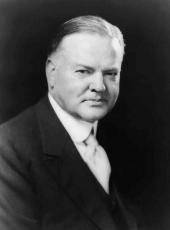IT WAS with particular satisfaction that I signed the rivers and harbors bill as it represents the final authorization of the engineering work by which we construct and coordinate our great systems of waterways and harbors, which I have advocated for over 5 years. It was promised in the last campaign and in my recommendations to Congress.
We can now build the many remaining segments of a definite canalization of our river systems through which modern barge trains of 10,000 to 15,000 tons of burden can operate systematically through the Midwest and to the Gulf of Mexico, and through the lakes to the Atlantic. The system, when completed, will have 12,000 miles of waterways and will give waterway connection between such great cities as New Orleans, Memphis, Knoxville, Chattanooga, St. Louis, Kansas City, Omaha, and Sioux City, Keokuk, Minneapolis, St. Paul, Chicago, Evansville, Cincinnati, Wheeling, and Pittsburgh. Through the Great Lakes and the Erie Canal many of those points will have access to central New York and the Atlantic. By its authorization for deepening of lake channels we shall support the present commerce of the Great Lakes and make preparation for ocean shipping by the ultimate deepening of the St. Lawrence. It authorizes numerous improvements in our harbors.
It is a long-view plan for the future. It will require many years to complete its construction. I do not propose that we should proceed in a haphazard manner, but that we should approach the problem on sound engineering lines, completing the main trunk systems and gradually extending the work outward along the lateral rivers.
Some of the items authorized have not yet been recommended by the engineers and, of course, they will not be undertaken unless they are so recommended.
The bill does not call for any increase in the budget for this fiscal year, the appropriations having been provided by which work will be pushed at all available points in assistance to the temporary unemployment situation.
I have, in cooperation with Secretary Hurley, established during the past year a new organization for the conduct of these works. In this organization we have created under Gen. Lytle Brown eight separate divisions, headed by responsible directing engineers, as follows:
Great Lakes Division Col. E. M. Markham
Upper Mississippi Valley Lt. Col. G. S. Spalding
Lower Mississippi Valley Brig. Gen. T. H. Jackson
North Atlantic Division Col. W. J. Borden
South Atlantic Division Col. H. B. Ferguson
Gulf Division Lt. Col. Mark Brook
North Pacific Division Col. G. Sukesli
South Pacific Division Lt. Col. T. M. Robins
|
In aggregate this inland waterway undertaking represents a larger project than even the Panama Canal. It will provide employment for thousands of men. It should be fruitful of decreased transportation charges on bulk goods, should bring great benefits to our farms and to our industries. It should result in a better distribution of population away from the congested centers. |
Note: Congress enacted the River and Harbor Act, H.R. 11781, on July 3, 1930, as Public, No. 520 (46 Stat. 918).
Maj. Gen. Brown was Army Chief of Engineers.
Herbert Hoover, Statement About Signing the River and Harbor Act. Online by Gerhard Peters and John T. Woolley, The American Presidency Project https://www.presidency.ucsb.edu/node/210986

